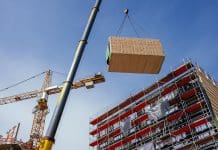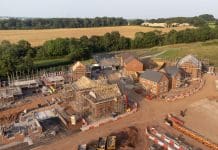In the wake of the chancellor’s budget earlier this month, Gary Cawley, director at CPC, gives the view from the North on the latest slew of policy announcements and funding promises, how they affect social housing providers, and identifies where they can most support the dual objectives of lower-carbon homes and modern methods of construction
With a quick PR picture on the stairs of 11 Downing Street and an hour-long speech in the Commons, Rishi Sunak delivered his highly-anticipated Covid-recovery budget.
This was going to be the ‘Big One’. The budget that laid out the path to economic recovery for the UK, would leave us encouraged that everything really is going to be alright in the end.
Ok, budgets are never that simple, but we could all do with a bit of positivity. So, despite the threat of probable tax hikes, we all had our fingers crossed for announcements about how we were really going to ‘build back better’.
Where did all the green go?
One of the things we were hoping for was some kind of extension to or replacement for the Green Homes Grant. Housing industry figures right across the board had been calling for it in the weeks leading up to March. It never came.
A scheme such as that has real potential to drive demand for low carbon retrofits, building capacity through investment in jobs, skills and innovation in the market.
Indeed, there’s a huge job to do right across the country’s existing housing stock if we’re going to meet the net zero aim for 2050. And it won’t come cheap. A recent study suggests the estimated cost of decarbonising each social home is £20,742, bringing the total potential cost of decarbonisation for the sector to £104bn.
But there was absolutely no mention at all about green retrofit from the chancellor, for private or public sector. Indeed, the Environmental Audit Committee has criticised the Government’s delivery of its decarbonisation agenda to date, and has called for an extension to the Local Authority Delivery Scheme, and front-loading of the money available through the Social Housing Decarbonisation Fund.
We’re pleased to see that the £562m available through these two schemes have been allocated – with lots coming to the North and Midlands with, for example, Leeds City Council receiving nearly £10m to retrofit 600 homes, and Mansfield District Council landing almost £1m for 154 homes – but much more is needed.
That’s not to say local authorities and registered providers won’t carry on with refurbishment and retrofit activities. CPC’s social housing clients are motivated by social purpose – to provide warm, safe, cheaper-to-run homes for their residents and green homes for the environment – and that won’t change.
But social housing providers should not be having to do the majority of the financial heavy lifting.
Social housing absolutely should be at the heart of any future policy. It should, in fact, have been at the heart of green homes retrofit policy from the very beginning, as providers have the will to deliver and the experience of doing so at scale.
If, for example, the Green Homes Grant had been flipped – £1.5bn for local authorities and £500m for private homeowners – there would have been no questions about demand, and suppliers would have been instilled with the confidence to invest in skills and capacity to deliver, building a great base for future programmes.
Encouragingly, the Construction Leadership Council is continuing to push for a National Retrofit Strategy, led by a Retrofit Delivery Authority akin to the stature of the Olympics Delivery Authority to oversee and lead strategy delivery, ensuring that all stakeholders, in particular locally-based delivery consortia, are fully enfranchised and that standards are high.
So perhaps there’s more to come from the chancellor. We wait in hope for the Spending Review later this year.
On the non-domestic front, it’s great to see projects allocated nearly £1bn of funding from the Public Sector Decarbonisation Scheme are now underway. The next tranche of funding – £75m for decarbonised heat – is set to open for applications on 7 April for those local authorities and other public sector organisations that are ready for low-carbon heating technology. Those projects will need to be completed by 31 March 2022; our N8 Energy Efficiency Measures and Associated Works framework features providers of such technology including, heat pumps.
Infrastructure Bank is welcome
What did receive a fuller airing in the budget was the promise of big investment in infrastructure, right across the UK, via two main routes:
- The £4.8bn Levelling Up Fund, which will focus on capital investment in local infrastructure
- The foundation of the UK Infrastructure Bank, which will aid both private and public sector organisations to achieve their development goals.
In fact, one potential chink of light for retrofit in this budget was to be found deep within the details of the UK Infrastructure Bank.
Due to launch this spring, the bank will have access to £12bn of equity and debt capital and will be able to issue up to £10bn of guarantees, with the aim of supporting up to £40bn of investment.
It will have two overarching aims: to help tackle climate change, and to support regional and local economic growth.
The document outlining the bank’s operations states: “Lending to local authorities across the UK will play a central role in meeting the bank’s objectives. It is increasingly clear that local actors have a vital role to play in achieving net zero emissions by 2050, for example through local energy solutions, coordinating retrofits or embedding change at the household level.”
The UK Infrastructure Bank does represent a very good opportunity for the levelling-up of communities across the UK, and we’re looking forward to finding out more about how it will operate and benefit the North. (As an aside, it was very pleasing to hear it will be based in Leeds, and the move of Treasury and other Government staff to Darlington is also to be congratulated).
A real opportunity for regeneration
The announcement of £4.8bn being made available through the Levelling Up Fund, to provide capital investment for local infrastructure projects, represents a real opportunity for regeneration across the North, especially in those areas that have received less attention from Government in recent years.
Town centres will be a heavy focus for the first round of funding this year. The Government wants to support projects that have a visible impact on people and communities, including transport, urban regeneration and cultural assets.
So while housing projects aren’t directly impacted by this policy, it will have great benefits to the construction supply chain and building businesses working in the regions, particularly SMEs, allowing them to invest in the jobs and technology that will also aid development in the housing sector.
For example, there may be projects for which Modern Methods of Construction (MMC) provide the perfect solutions, such as the regeneration of brownfield sites.
On the MMC front, it was particularly welcome to hear of the £10m seed funding for the MMC Taskforce, which will accelerate the delivery of MMC homes. The taskforce will consist of world-leading experts from across Government and industry to fast-track the adoption of MMC.
Reference has been made to Northern pioneers such as Liverpool City Region, which demonstrates the huge appetite there is in the North to revolutionise housing in a modern and sustainable way.
CPC has already been helping local authorities deliver exciting and cutting-edge MMC projects through its Offsite Construction of New Homes (NH2) and Modular Buildings (MB1) frameworks, and we hope that the Taskforce will help to inspire NHC members to continue to lead the way.
For details on CPC’s frameworks, see www.cpconstruction.org.uk/frameworks/.














